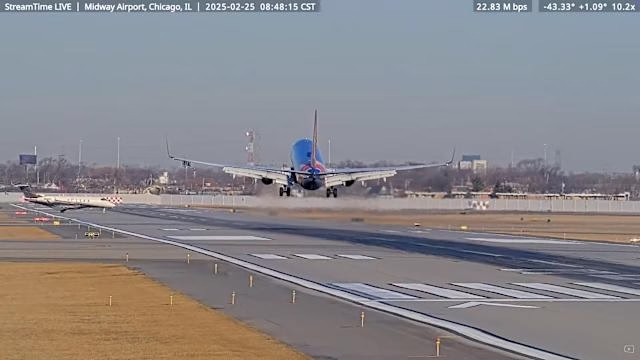—
SOUTHWEST PLANE NEARLY COLLIDES WITH PRIVATE JET AT CHICAGO MIDWAY AIRPORT
Frightening near-miss sparks federal investigation and renewed calls for stricter air traffic control regulations
CHICAGO – A catastrophic disaster was narrowly avoided Tuesday morning when a Southwest Airlines Boeing 737 came within 150 feet of colliding with a private jet on a busy runway at Chicago Midway International Airport. The incident, which occurred just before 9:00 a.m. local time, has sparked federal investigations, grounded both aircrafts involved, and raised serious concerns over air traffic management at one of the nation’s most congested urban airports.
According to initial reports from the Federal Aviation Administration (FAA), Southwest Flight 4823, bound for Dallas Love Field, was accelerating for takeoff on Runway 4R when a privately owned Bombardier Challenger 300, arriving from Naples, Florida, mistakenly taxied across the same runway—apparently without clearance.
The pilot of the Southwest flight, Captain Teresa Mendez, 42, noticed the private jet encroaching from the right side just seconds before reaching full throttle. Her quick decision to abort takeoff and apply emergency braking likely saved the lives of all 143 passengers and five crew members on board.
“The crew acted with exceptional skill and discipline under enormous pressure,” said Southwest Airlines CEO Bob Jordan in a press conference hours after the incident. “We are grateful that no one was injured and that our pilots followed protocol to the letter.”
Eyewitnesses in the terminal and on the tarmac described the scene as “terrifying.” One traveler, Janice Holloway, who was waiting for a flight to Minneapolis, said she saw the two planes “barreling toward each other” and heard people in the terminal screaming.
“They were seconds from hitting. I’ve never seen anything like that in my life,” Holloway told reporters. “When that Southwest plane suddenly stopped and veered slightly to the side, everyone just froze. You could see the fear on the faces in the windows.”
Security camera footage released by airport authorities shows just how close the aircrafts came to disaster. The video, now circulating widely online, shows the Southwest plane skidding slightly as it halts near the intersection, while the private jet rolls obliviously into its path. Investigators say the two aircrafts were separated by approximately 150 feet at their closest point—well within the threshold for a near-collision, and just seconds from impact at their respective speeds.
The National Transportation Safety Board (NTSB) has launched a full-scale investigation into the incident. Preliminary findings suggest miscommunication between air traffic control and the pilot of the Challenger jet, who was reportedly unfamiliar with Midway’s layout and procedures.
Sources close to the investigation revealed that the private jet, registered to Hawthorne Capital Group—a New York-based investment firm—was carrying three executives and a pilot identified as 61-year-old Roger Whitman, a retired Air Force colonel with over 20 years of flying experience.
Initial transcripts from the cockpit voice recorder suggest Whitman was under the impression he had been cleared to cross Runway 4R. However, investigators are scrutinizing whether his interpretation of the instruction differed from what was actually given.
“We’re looking at human factors, communication protocols, and airport signage,” said NTSB Chair Jennifer Homendy during a late afternoon press briefing. “This was a serious lapse, and we are treating it as such. The margin for error in aviation is razor-thin.”
The FAA has confirmed that both planes have been grounded for inspection, and that the air traffic controller responsible for the sector at the time has been placed on administrative leave pending further review.
The incident comes amid growing concerns over runway incursions at major U.S. airports. According to FAA data, 2024 saw a 17% increase in near-miss events, many attributed to increased traffic following a post-pandemic travel boom and ongoing staffing shortages.
“This is the latest wake-up call,” said aviation analyst and former commercial pilot Mark Eisenberg. “Airports like Midway are operating at the edge of capacity. You’ve got multiple runways, intersecting taxiways, heavy commercial and private traffic—and sometimes a moment’s confusion or delay in communication is all it takes for disaster to unfold.”
Union representatives for air traffic controllers and pilots have both cited chronic fatigue and outdated technology as contributing factors to such incidents. Calls for modernization of air traffic systems and better cross-training for general aviation pilots unfamiliar with major commercial airports have grown louder in recent months.
Meanwhile, travelers at Midway remain rattled. Southwest confirmed that Flight 4823 was delayed several hours while a replacement aircraft and crew were arranged. All passengers were rebooked and given travel vouchers and accommodations.
“We’re still shaken,” said passenger Harold Wu, who was traveling to Dallas on business. “Everyone clapped for the pilots. They saved our lives. But I keep thinking—what if she hadn’t seen the jet? What if it had been just five seconds later?”
Chicago Mayor Brandon Johnson issued a statement praising the Southwest crew and first responders for their professionalism, and pledged full cooperation with federal authorities. “We are thankful for the safe outcome today, but we must never become complacent,” the mayor said. “Safety must remain our number one priority.”
As investigators continue piecing together the sequence of events, the NTSB has indicated it may release a preliminary report within the next 10 days. In the meantime, both the FAA and the Department of Transportation are expected to review procedural safeguards in place at Midway and potentially recommend policy changes for handling private aircraft at commercial hubs.
For many, this near-tragedy serves as a grim reminder of the ever-present risks in modern air travel—and the razor-thin moments that can separate routine from catastrophe.
—
